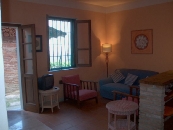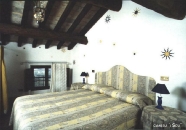Agriturismo Castello di Luzzano
Loc.Luzzano, 5, Rovescala 27040 Rovescala (Pavia)
-
Restaurant
-
Pets welcome
Profile
In brief
- Type: Suite (1), Bedroom (3), Flat (5),
- Guests: 34
- Map: Hills
- Type of accommodation: Room only, Bed & Breakfast
The agriturismo
A hilltop hamlet where the view sweeps over the hills ofOltrepò and Piacentino, straddling Lombardy and Emilia. Around the castle, ancient in origin but 17th-century in present appearance, 17th-century rural houses gather along an avenue leading to a neoclassical church.
The accommodation
Luzzano is a farm made up of a very small village in the middle of a large hillside all planted with vineyards.
It is located about 300 m.t. above sea level on the first hills rising from the Po Valley between Piacenza and Pavia: the Oltrepo Pavese
. The hamlet is formed by the Castle of Roman origin, rural houses dating back to the 1600s, and the beautiful neoclassical church.
The renovation project began in the 1980s, with the intention of a total building renovation that would bring the hamlet back to its former being, when so many families lived there and the farm was full of life. The intent was to transform the farmers' homes into apartments for the winery's guests, to provide an environment where one could breathe history, art and wine culture.
The 18th-century Customs House at the entrance to the property has recently been transformed with rooms and a small romantic restaurant.
Each apartment and room is built little by little, each with its own particular soul (there is Clara's House, Paola's House, Adriana's House, Mirella's House, etc.).
The complex of apartments on the outside, has been unified by red-colored lime plaster, but on the inside each house is different from the other: one is yellow, one is pink, (all however strictly with lime colors plus oxides), one is exposed brick, the other with walls partly left stone
. Inside for the stairs, furniture, tables, only woods from trees on the farm are used. Each house has its own essence: elm, Lebanon cedar, yew, cypress, cherry.
All made by good and patient craftsmen from around there. New or reclaimed terracotta tiles, treated with linseed oil and wax, were used for the floors, and in some rooms on the upper floor the old gray grit tiles were left in place.
Old vines cut in the renewal of the vineyards were mostly used for the lights
. The furniture: pictures, frames, sofas, was made on the farm according to the various destinations and choosing shapes, colors and materials.
The apartments are all on two floors: on the ground floor the kitchen and living room, upstairs one or more bedrooms with bathrooms.
On the front, only a beautiful view of vineyards. At the back, the old porch, once a shelter for wood and farmyard animals, is now a place where you can stop in peace to have lunch or sunbathe among lavender, sage and rosemary hedges and laurel, pomegranate and pittosporum bushes.
The accommodation availability consists of apartments of different types: two-room apartment for two people, three-room apartment for four, three-room apartment for four to six people, and for six to eight we have a five-room apartment. All with bathroom and complete household equipment.
The Inn, with rooms and suites, was opened in April '99.All apartments have a private bathroom, as do the rooms.
Activities and surrounding
We visit the area on the border between Oltrepò and Piacentino: places rich in history and centuries-old struggles. The lords who ruled there - the Visconti, Dal Verme, Malaspina - from the 11th to the 16th century, defended such difficult borders by erecting numerous fortifications and castles.
Here, amidst beautiful views of vineyards, one encounters small rural villages, castles, towers and fortresses, including Rovescala, Soriasco, Golferenzo, Volpara, Zavattarello and Romagnese in Pavia; Rocca d'Oolgisio in Piacenza-one of the most interesting castle constructions dating back to 550 AD.C.
Near Romagnese, a visit to the Pietra Corva botanical garden
is recommended while, on the way back, gourmands can buy excellent cured meats, including the famous coppa piacentina, in Pienello.
Having more time on your hands, a detour to Bobbio in the Trebbia Valley, made famous by theAbbey of St. Colombano and numerous other medieval testimonies, is recommended. These include the Gobbo Bridge from the Romanesque period, as well as the cathedral renovated in the Baroque period. The most distinguished monument is the Abbey of St. Columbanus built in 612 by the Irish monk Columbanus and later ordered by the Benedictines who made it a beacon of culture in the Middle Ages.
We also recommend visiting: the Charterhouse of Pavia, Castell'Arquato, the Visconti village of Grazzano Visconti and the archaeological center of Velleia Romana
.
VISITS TO CASTLES
Agazzano: April-October holidays 11 a.m. and 3 p.m.-5.30 p.m.Bastardina
: April-October holidays 10 a.m.-12.30 p.m. and 2
. 30-18Castell
'Arquato: April-October Saturday and holidays 10-12 and 15-18 weekdays 10-12 and 15-17Gropparello
: March-November holidays 10-19Rivalta
: March-November Saturday and Sunday 9-12 and 15-18.00Rocca
d'Olgisio: April-October holidays 9.30-12 and 15.30-18.30S
.
Pietro in Cerro: March-October holidays 11 a.m. and 3-6
p.m. Sarmato: May-June-September holidays 3-6 p.m.
Services
Available services
Restaurant & Events
Open to
Everyone
Table reservation
Reservation needed
Seats
Up to 40
Menu
Set menu
Specialties you may find
- Paste fatte in casa
- Animali di bassa corte dai nostri allevamenti
- Legumi, vegetali e formaggi da coltivazioni naturali
Wedding in Italy, Parties & Celebrations
Corporate Events
The owner was very friendly and helpful.
(Translated with DeepL Translate) Read more
(Translated with DeepL Translate) Read more
- This host is committed to providing products and services that comply with the applicable standards of Union law.
- On Agriturismo.it since 2008
- Speak: Italian
- He/she usually responds within more than 24 hours
Map
Rovescala (Pavia) Print directions from host
The telephone number is:
+39.0523863277
By calling the phone number I declare that I am of age and accept the terms and conditions of use and privacy policy.
The fax is:
+39.0523865909








